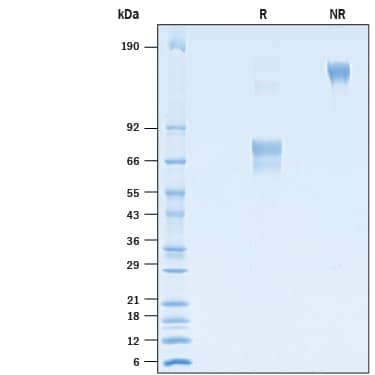Recombinant Canine PD-L1/B7-H1 Fc Chimera Protein, CF
R&D Systems, part of Bio-Techne | Catalog # 10746-B7

Key Product Details
Source
HEK293
Accession #
Structure / Form
Disulfide-linked homodimer
Conjugate
Unconjugated
Applications
Bioactivity
Product Specifications
Source
Human embryonic kidney cell, HEK293-derived canine PD-L1/B7-H1 protein
| Canine PD-L1/B7-H1 (Phe19-Arg236) Accession # NP_001278901.1 |
IEGRMD | Human IgG1 (Pro100-Lys330) |
| N-terminus | C-terminus |
Purity
>95%, by SDS-PAGE visualized with Silver Staining and quantitative densitometry by Coomassie® Blue Staining.
Endotoxin Level
<0.10 EU per 1 μg of the protein by the LAL method.
N-terminal Sequence Analysis
Phe19
Predicted Molecular Mass
51 kDa
SDS-PAGE
60-80 kDa, under reducing conditions
Activity
Measured by its binding ability in a functional ELISA.
When Recombinant Canine PD-1 Fc Chimera (Catalog # 10553-PD) is immobilized at 0.5 µg/mL (100 µL/well), Recombinant Canine PD-L1/B7-H1 Fc Chimera (Catalog # 10746-B7) binds with an ED50 of 0.30-4.50 µg/mL.
Scientific Data Images for Recombinant Canine PD-L1/B7-H1 Fc Chimera Protein, CF
Recombinant Canine PD-L1/B7-H1 Fc Chimera Protein Binding Activity.
When Recombinant Canine PD-1 Fc Chimera (10553-PD) is immobilized at 0.5 µg/mL (100 µL/well), Recombinant Canine PD-L1/B7-H1 Fc Chimera (Catalog # 10746-B7) binds with an ED50 of 0.30-4.50 µg/mL.Recombinant Canine PD-L1/B7-H1 Fc Chimera Protein SDS-PAGE.
2 μg/lane of Recombinant Canine PD-L1/B7-H1 Fc Chimera (Catalog # 10746-B7) was resolved with SDS-PAGE under reducing (R) and non-reducing (NR) conditions and visualized by Coomassie® Blue staining, showing bands at 60-80 kDa and 120-160 kDa, respectively.Formulation, Preparation and Storage
10746-B7
| Formulation | Lyophilized from a 0.2 μm filtered solution in PBS with Trehalose. |
| Reconstitution | Reconstitute at 500 μg/mL in PBS. |
| Shipping | The product is shipped with polar packs. Upon receipt, store it immediately at the temperature recommended below. |
| Stability & Storage | Use a manual defrost freezer and avoid repeated freeze-thaw cycles.
|
Background: PD-L1/B7-H1
References
- Greenwald, R.J. et al. (2005) Annual Review of Immunology 23:515.
- Collins, Mary et al. (2005) Genome biology 6:223.
- Frigola, X. et al. (2011) Clin. Cancer Res. 17:1915.
- Daassi, D. et al. (2020) Nat Rev Immunol. 20:209.
- Ray, A. et al. (2015) Leukemia. 29:1441.
- Zhao, Y. et al. (2018) Oncotarget. 9:14803.
- Herold, M. et al. (2015) J. Immunol. 195:3584.
- Jiang, Y. et al. (2020) Canc lett. 468:72.
Long Name
Programmed Death Ligand 1
Alternate Names
B7-H1, B7H1, CD274, PDCD1L1, PDCD1LG1, PDL1
Entrez Gene IDs
Gene Symbol
CD274
UniProt
Additional PD-L1/B7-H1 Products
Product Documents for Recombinant Canine PD-L1/B7-H1 Fc Chimera Protein, CF
Product Specific Notices for Recombinant Canine PD-L1/B7-H1 Fc Chimera Protein, CF
For research use only
